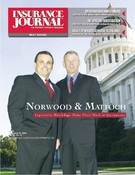Replacement cost, policy limits, and non-renewal of policies were the source of a heated debate in a day-long hearing investigating underinsured homeowners affected by last year’s wildfires.
California Insurance Commissioner John Garamendi held a statewide investigative hearing in San Diego Oct. 21 to discuss what the Commissioner called a “crisis in coverage,” asking major insurance companies why California’s homeowners are underinsured. The investigation stemmed from the California wildfires of October 2003, which burned thousands of homes in three counties: San Diego, Riverside, and San Bernardino.
“Insurers work with homeowners to help them make the right coverage decisions,” said representatives of the Personal Insurance Federation of California (PIFC), American Insurance Association (AIA), and the Association of California Insurance Companies (ACIC), in a statement.
“It makes no financial or business sense for insurance companies to intentionally underinsure their customers.”
The hearing featured testimony from representatives of industry trade associations, insurance companies, consumer advocates, wildfire victims and a property valuation solution provider.
Garamendi addressed pointed questions and comments to representatives from several subpoenaed insurers, including the Interinsurance Exchange of the Automobile Club, Allstate Insurance Co., Farmers Insurance, and State Farm Insurance.
He lauded the Automobile Club for the implementation of their Guaranteed Replacement policy, but delivered harsh words to the representatives of Allstate, Farmers and State Farm. He grilled representatives on why policies are reportedly so deficient when it came to replacement coverage. He urged insurers to practice more disclosure with consumers.
Marshall & Swift/Boeckh, a Los Angeles-based residential and commercial property valuations firm, which supplies insurance companies with software designed to evaluate the replacement cost of property, testified in defense of its products. Many insurers reportedly rely heavily on MS/B’s technology when underwriting homeowners’ policies.
A point of contention was MS/B’s Quick Quote software program, which gives homeowners a rapid estimate of policy limits. MS/B insisted that agents and brokers rarely utilize Quick Quote, which one consumer advocate said was severely deficient in estimating replacement cost. The MS/B Full Quote program was generally agreed to be sufficient in estimating replacement home cost.
Many homes lost in the wildfires, however, were reportedly underestimated in value by $100,000 to $300,000.
The commissioner also reprimanded insurers for limiting Additional Living Expenses (ALE) to one year, and called upon them to extend the ALE to those who have not yet resolved their claims and/or have not yet rebuilt.
Steve Young, general counsel for IBA West, testified on behalf of insurance agents. “An agent or broker has absolutely no incentive whatsoever to undersell insurance,” Young said. “If they undersell insurance, they are liable from an errors & omissions standpoint for that failure.”
Young suggested that the language on policies and disclosures be made clearer, more accurate and more simplified, and that homeowners also do their part by being better informed of the terms of their policy.
He also suggested that the idea that agents and brokers make personal visits to each and every home to assess accurate property value is unrealistic and not cost-worthy.
The responsibility for understanding true valuations, he said, “really rests, rightly or wrongly, with consumers.
“There has to be better disclosure on how these valuations are calculated,” Young added.
Curtis Moring, owner of San Diego-based Curtis Moring Insurance Agency, also testified on behalf of agents, stating that agents and brokers must keep abreast of the changes in the homeowners industry, and in particular, in the cost of building homes.
Independent insurance agent David Shaffer, owner of Walnut Creek, Calif.-based David Shaffer Mortgage and Insurance Services, spoke on behalf of consumer advocacy group United Policyholders. He offered several potential solutions to the underinsurance problem.
“Underinsurance can be prevented, but only with drastic changes,” Shaffer said. He recommended that the insurance commissioner help better educate the general public on the reality of the underinsurance program by reporting data on actual fire losses and actual reconstruction costs.
He also recommended that the insurance commissioner publish such information on the Department of Insurance’s (DOI) Web site for public viewing. He demonstrated that in some cases, for only a dollar more per day, consumers could double their insurance coverage.
Shaffer proposed that the DOI establish a uniform appraisal process within the industry, and asked the DOI to explore why some insurers are placing building code exclusions in policies, even when homes are up-to-date.
“As an insurance professional, it is not my responsibility to set the policy limits of the house or the contents,” Shaffer contended. “I am an expert on policies and forms. I educate my clients on what makes a policy better than another.”
Garamendi urged consumers with serious claims to proceed with legal action before the one-year deadline to file claims passed. In addition, he also encouraged them to contact the DOI to set up mediation with the insurer in order to resolve claims quickly.
Garamendi placed most, if not all of the blame with insurers, stating that they are an “informed, knowledgeable party in the transaction.” Garamendi insinuated that policyholders were not responsible in any part for underinsured homes. “I want this industry to take the responsibility to make an accurate recommendation to the customer, and then let the customer make an informed decision,” he said.
What was not discussed in detail, however, was the problem of inflated and unjust reconstruction costs brought upon by contractors and builders taking advantage of the crisis situation to make a quick profit.
“Contractors can give you different prices for the same product,” Dan Dunmoyer, president of the PIFC, told Insurance Journal. “It’s not just what somebody quotes the price at; it’s what the actual cost to rebuild is. When you look at disasters, when there is post-disaster inflation, you have to take into account that the first bid given by a contract may not be the final bid that gets the home built. Consumers are quoted as high as $250 a square foot, but many times those homes were built at $105 a square foot by the same builder. That was never mentioned tonight.”
When asked if it would be possible for insurers to provide full coverage without raising premiums, Garamendi told IJ, “If all homes are insured to the real value, the real cost of construction, then the pool of money that’s available is larger, and rates should decline because the losses are not going to increase here, but you are still going to have the same proportion of catastrophic losses. So individual homes might, but for the overall community, rates should not go up, in fact they should decline for everybody. The total premiums collected should not change.”
Following the hearing, Garamendi issued a report stating that survivors from the 2003 wildfires who suffered total losses filed formal complaints with the DOI at a rate of 22 times higher than the normal rate of complaints.
Of the 2,734 “total-loss” claims filed with insurers following the fires, the DOI found some 22 percent–or 676 claims–produced complaints over the handling of the claim by the insurer.
The PIFC released a statement following Garamendi’s report in defense of insurers. “We are confused about the CDI statistics,” said Dunmoyer in the statement. “It is disturbing that CDI’s facts concerning our member companies do not include all the factors in play after a large loss. In the simplistic way CDI data is presented, it overlooks many of the reasons why many homes may have not been rebuilt following the fires. CDI assumes every fire victim rebuilds their identical house in the identical spot after a total loss. The insurance industry knows conclusively this is often not the case,” Dunmoyer said.
He noted that many factors were not taken into consideration, including homeowners who have decided not to rebuild and have relocated after the fires, as well as several other issues that may have stymied construction across the state.
“The CDI statistics are confusing when one takes a closer look,” Dunmoyer continued. “For instance, the report fails to point out that there were 676 total complaints out of a total of 19,100 insurance claims filed from the fires. When you compare the total complaints to the total claims (apples to apples) the ratio of 22 percent cited in the CDI report turns out actually to be only 3.5 percent according to the Insurance Services Office. That’s quite a difference,” Dunmoyer said.
“Granted, one justified complaint from an unhappy policyholder is too many,” Sam Sorich, president of the ACIC, said in a statement. “But the percentage of complaints is relatively low considering the magnitude of the disaster and the numerous difficulties experienced during the recovery process, such as locating materials and builders. Insurers are committed to the homeowners insurance market for the long haul. Therefore, it is important that insurers keep the claims process as problem-free as possible.”
For video coverage of Garamendi’s wildfire hearings, visit https://www.insurancejournal.com/broadcasts/video/.
Topics Catastrophe Natural Disasters California Carriers Agencies Wildfire Claims Homeowners
Was this article valuable?
Here are more articles you may enjoy.


 Business Moves: ALKEME Expands in US With Addition of 5 Agencies
Business Moves: ALKEME Expands in US With Addition of 5 Agencies  Experian: AI Agents Could Overtake Human Error as Major Cause of Data Breaches
Experian: AI Agents Could Overtake Human Error as Major Cause of Data Breaches  Trump Nominates WeatherTech’s MacNeil to Be FTC Commissioner
Trump Nominates WeatherTech’s MacNeil to Be FTC Commissioner  Allstate Can Proceed With Recovery in Texas RICO Case: Fifth Circuit
Allstate Can Proceed With Recovery in Texas RICO Case: Fifth Circuit 


